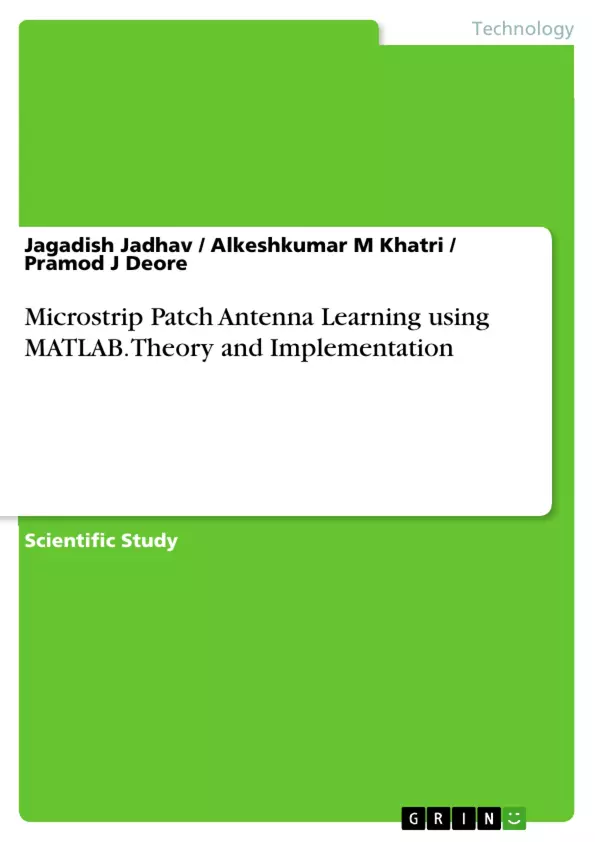Microstrip patch antenna is used to send onboard parameters of article to the ground while under operating conditions. By the study of this book we find out how to investigate a new method of teaching microstrip patch antenna design for undergraduate students by using MATLAB.
Effect of changes in basic parameter microstrip patch antenna on its radiation pattern and other parameters to study the effect of resonant frequency and substrate parameters like, relative dielectric constant, substrate thickness on the radiation parameters of bandwidth and physical dimension of the microstrip patch antenna can be determined by using GUI. In this book we develops simple CAD (GUI) formulas that describe the basic properties of microstrip patch antenna using MATLAB. By the usage of this teaching tool we can analyze the behaviour of the microstrip patch antenna and design of it for different material.
Satellite communication and wireless communication has been developed rapidly in the past decades and it has already a dramatic impact on human life. In the last few years, the development of wireless local area networks (WLAN) represented one of the principal interests in the information and communication field.
Thus, the current trend in commercial and government communication systems has been to develop low cost, minimal weight, low profile antennas that are capable of maintaining high performance over a large spectrum of frequencies. This technological trend has focused much effort into the design of microstrip (patch) antennas. The variety in design that is possible with microstrip antenna probably exceeds that of any other type of antenna element.
In addition, once the shape and operating mode of the patch are selected, designs become very versatile in terms of operating frequency, polarization, pattern, and impedance. They are extremely low profile, lightweight, simple and inexpensive to fabricate using modern day printed circuit board technology, compatible with microwave and millimeter-wave integrated circuits (MMIC), and have the ability to conform to planar and non planar surfaces.
Inhaltsverzeichnis (Table of Contents)
- INTRODUCTION
- Motivation
- Problem Defination
- Objective of Book
- Organization of the Book
- LITERATURE REVIEW
- Inovation of Microstrip Patch Antenna
- Optimization for High Frequency Use
- Multi frequency Opertion
- Mathematical Analysis and Implementation
- THEORY OF MICROSTRIP PATCH ANTENNA
- Basic Structure
- Advantages and Disadvantages
- Feed Techniques
- Microstrip Line Feed
- Coaxial Feed
- Aperture Coupled Feed
- Proximity Coupled Feed
- Methods of Analysis
- Transmission Line Model
- Cavity Model
- Full Wave Solution Method of Moments
- Applications.
- Mobile and satellite communication application
- Global Positioning System applications
- Radio Frequency Identification (RFID).
- Worldwide Interoperability for Microwave Access (WiMax)
- Radar Application
- Rectenna Application
- Telemedicine Application
- Medicinal applications of patch
- IMPLEMENTATION OF GUI FOR MICROSTRIP PATCH ANTENNA
- Antenna Essential Parameters.
- GUI of Microstrip Patch Antenna
- RESULTS & FUTURE SCOPE
- Results.
- Future Scope
- CONCLUSIONS
Zielsetzung und Themenschwerpunkte (Objectives and Key Themes)
This book aims to provide a comprehensive overview of microstrip patch antennas, covering their theory, design, implementation, and applications. It explores the evolution of these antennas, their advantages and limitations, and various feed techniques. The book also delves into the mathematical analysis and modeling of microstrip patch antennas and their use in various communication and sensing applications.
- The theory and design of microstrip patch antennas
- Different feed techniques for microstrip patch antennas
- Mathematical analysis and modeling of microstrip patch antennas
- Applications of microstrip patch antennas in communication and sensing
- Implementation of a graphical user interface (GUI) for designing microstrip patch antennas
Zusammenfassung der Kapitel (Chapter Summaries)
- INTRODUCTION: This chapter introduces the motivation behind studying microstrip patch antennas, defines the problem addressed in the book, outlines the objectives, and provides an overview of the book's organization.
- LITERATURE REVIEW: This chapter explores the evolution of microstrip patch antenna technology, focusing on key innovations, optimization techniques for high-frequency applications, multi-frequency operation, and mathematical analysis and implementation methods.
- THEORY OF MICROSTRIP PATCH ANTENNA: This chapter delves into the fundamental principles of microstrip patch antennas, covering their basic structure, advantages and disadvantages, various feed techniques (including microstrip line feed, coaxial feed, aperture-coupled feed, and proximity-coupled feed), and methods of analysis (such as transmission line model, cavity model, and full wave solution method of moments). It also discusses applications of microstrip patch antennas in mobile and satellite communication, Global Positioning Systems, RFID, WiMax, radar, rectennas, telemedicine, and medicinal fields.
- IMPLEMENTATION OF GUI FOR MICROSTRIP PATCH ANTENNA: This chapter focuses on the practical implementation of a graphical user interface (GUI) for designing rectangular microstrip patch antennas. It covers essential parameters and functionalities of the GUI.
- RESULTS & FUTURE SCOPE: This chapter presents the results obtained from the GUI implementation and discusses potential future directions for research and development in the field of microstrip patch antennas.
Schlüsselwörter (Keywords)
The primary keywords and focus topics of this book include microstrip patch antennas, antenna design, feed techniques, mathematical analysis, modeling, applications, communication systems, sensing, GUI, and future trends.
- Citar trabajo
- Jagadish Jadhav (Autor), Alkeshkumar M Khatri (Autor), Dr. Pramod J Deore (Autor), 2021, Microstrip Patch Antenna Learning using MATLAB. Theory and Implementation, Múnich, GRIN Verlag, https://www.grin.com/document/1037777



